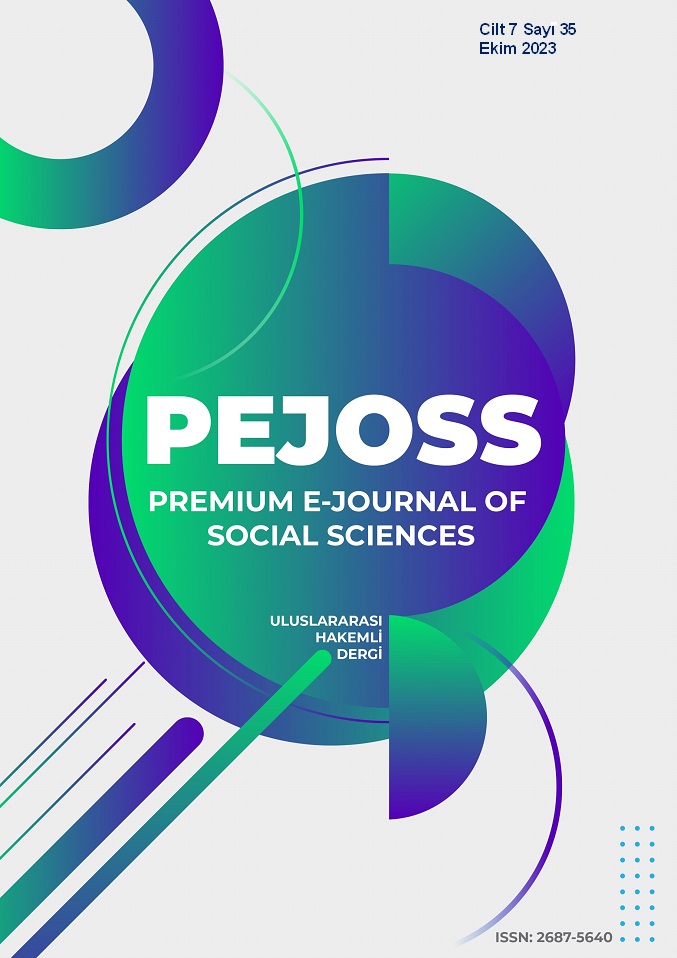The Development of International Trade in Türkiye in The Century of The Republic
DOI:
https://doi.org/10.5281/zenodo.10029104Keywords:
Republic, International Trade, Export, ImportAbstract
Today, international trade is seen as one of the most important tools in the development of countries, sustaining economic growth and ensuring integration with other countries. The Republic of Türkiye has not remained indifferent to the process of change in international trade in the world. As a matter of fact, with the proclamation of the Republic in 1923, Türkiye has developed various strategies in order to be a part of the globalization and rapid change process occurring in the world trade scene. In the period from the declaration of the Republic to the present day, international trade strategies have been determined according to the national and international conditions of each period and importance has been given to ensuring international trade balance by increasing exports. It is seen that in the first years of the establishment of the Republic of Türkiye, it was significantly negatively affected economically by two important wars, the First World War and the War of Independence. In the early years of the Republic, the agricultural sector provided a large portion of export income in international trade. Today, Türkiye's international trade structure differs greatly from its structure in the founding period. Over the course of a century, international trade, which has developed through foreign economic relations, has significantly affected development and industrialization. However, changes in domestic economic policy also had an impact on international trade. Within the scope of the study, international trade strategies implemented in the periods from the proclamation of the republic until today, internal and external factors affecting international trade, and international trade volumes according to periods are examined. The aim of the study is to reveal Türkiye's development in international trade from a historical perspective, from the first period of the Republic of Türkiye to the centenary of the republic.
Downloads
References
Aksoy, B. ve Coşkun, M. (2004). Türkiye’nin yakın dönem dış ticaretindeki değişmeler. GÜ Gazi Eğitim Fakültesi Dergisi, 24(3), 397-415.
Akyıldız, H. ve Eroğlu Ö. (2004). Türkiye Cumhuriyeti dönemi uygulanan iktisat politikaları. Süleyman Demirel Üniversitesi İktisadi ve İdari Bilimler Fakültesi Dergisi, 9(1), 43-62.
Balkanlı, A.O. (2002). Küresel ekonominin belirleyici faktörleri üzerine. Uludağ Üniversitesi İktisadi İdari Bilimler Fakültesi Dergisi, 11(1), 13-26.
Boratav, K. (2006). Türkiye iktisat tarihi 1908-2005. İmge Kitabevi.
Bulut, C. (2006). Ekonomik yapı ve politika analizi. Der Yayınları.
Çelebi, E. (2001). Türkiye’de devalüasyon uygulamaları 1923-2000. Doğuş Üniversitesi Dergisi,3, 55-66.
Çelik, T. (2022). Türkiye’de 1980 sonrası makroekonomik gelişmeler ve dış ticaret. O. Öcal & V. Han (Eds). Dış ticarette güncel tartışmalar Türkiye üzerine bir inceleme (ss.33-53). Çizgi Yayınevi.
Dereli, D. D. (2018). Türkiye’de ekonomik büyüme ile dış ticaret arasındaki nedensellik ilişkisi (1969-2016). Yönetim ve Ekonomi Araştırmaları Dergisi, 16(3), 279-289.
Eroğlu, N. (2007). Atatürk dönemi iktisat politikaları (1923-1938). Marmara Üniversitesi İktisadi ve İdari Bilimler Fakültesi Dergisi, 23(2), 63-73.
Gözcü, A. (2008). 1929 ekonomik bunalımı sonrasında dünyada “Yeni Türkiye” algısı ve Türkiye’nin ekonomik arayışlarına ilişkin saptamalar. Çağdaş Türkiye Tarihi Araştırmaları Dergisi, 7(16), 273-289.
Güleç, M., ve Oğuz, G. (2003). Irak savaşının gölgesinde Türkiye Ortadoğu ülkeleri ticari ilişkileri. Dış Ticaret Müsteşarlığı Yayınları.
Kepenek, Y.ve Yentürk, N. (2005). Türkiye ekonomisi. Remzi Kitabevi.
Kızıltan, A. ve Ersungur, M. Ş. (2009 Mayıs). Türkiye ekonomisinde sektörlerin istihdama etkileri: girdi-çıktı yaklaşımıyla bir uygulama. 10. Ekonometri ve İstatistik Sempozyumu, Atatürk Üniversitesi İ.İ.B.F., Erzurum.
Kızıltan, A., Ersungur, M. Ş. ve Polat, Ö. (2008). Gümrük Birliği’nin Türkiye’nin Avrupa Birliği ile ihracat ve ithalatına etkisi. Atatürk Üniversitesi İİBF Dergisi, 22(1), 83-99.
Mazlum, N. (2020). 1980-2018 dönemi Türkiye ekonomisi ve dış ticaretinin gelişim seyri. Gümrük Ticaret Dergisi, 7(22), 54-71.
Özcan, H.A. (1998). Dünden bugüne dış ticaretimizdeki gelişmeler. Dış Ticaret Dergisi, özel sayı, 41-76.
Özdemir, Ü., Kantürk Yiğit, G. & Oral, M. (2016). Cumhuriyetten günümüze ekonomi politikaları bağlamında Türk dış ticaretinin gelişimi. Doğu Coğrafya Dergisi, 21(35), 149-174.
Özkale, L. ve Kayalıca, M.Ö. (2008). Dış ticaretin yapısal gelişimi. G.E. Arslan (Ed). Çeşitli yönleriyle cumhuriyetin 85. Yılında Türkiye ekonomisi (s. 355-382). Gazi Üniversitesi Hasan Ali Yücel Araştırma ve Uygulama Merkezi Yayını.
Strateji ve Bütçe Başkanlığı (2023). Orta vadeli plan, 2023-2025. https://www.sbb.gov.tr/wp-content/uploads/2022/09/orta-vadeli-program-2023-2025.pdf.
Şahin, H. (2009). İktisada giriş. Ezgi Kitabevi Yayınları.
Şahin, H. (2016). Türkiye ekonomisi. Ezgi Kitabevi Yayınları.
Ticaret Bakanlığı. (2023). Dış ticaret veri bülteni Ağustos 2023. https://ticaret.gov.tr/haberler/2023-yili-agustos-ayi-dis-ticaret-verileri.
Tonus, Ö (2007). Gümrük Birliği sonrasında Türkiye’de dışa açıklık ve sanayileşme. Dumlupınar Üniversitesi Sosyal Bilimler Dergisi, 17, 193-214.
Topallı, N. (2022). Türkiye ekonomisinde dış ticaretin gelişimi. O. Öcal ve V. Han (Eds). Dış ticarette güncel tartışmalar Türkiye üzerine bir inceleme (ss.7-32). Çizgi Yayınevi.
TÜİK (2023). Dış ticaret istatistikleri. www.tuik.gov.tr.
Uludağ, İ.ve Arıcan, E. (2003). Türkiye ekonomisi teori, politika, uygulama. Der Yayınları.
UNICTAD. (2021). Global trade update, november, https://unctad.org/webflyer/global-trade-updatenovember-2021, 1-8.
Varol, G. M. (2003). Cumhuriyetin 80. yılında 1923-2003 Türk dış ticaretinin gelişiminin kısa tarihçesi. Dış Ticaret Dergisi, (Özel Sayı), s. 159-161.
Downloads
Published
How to Cite
Issue
Section
License
Copyright (c) 2023 Premium e-Journal of Social Science (PEJOSS)

This work is licensed under a Creative Commons Attribution 4.0 International License.


